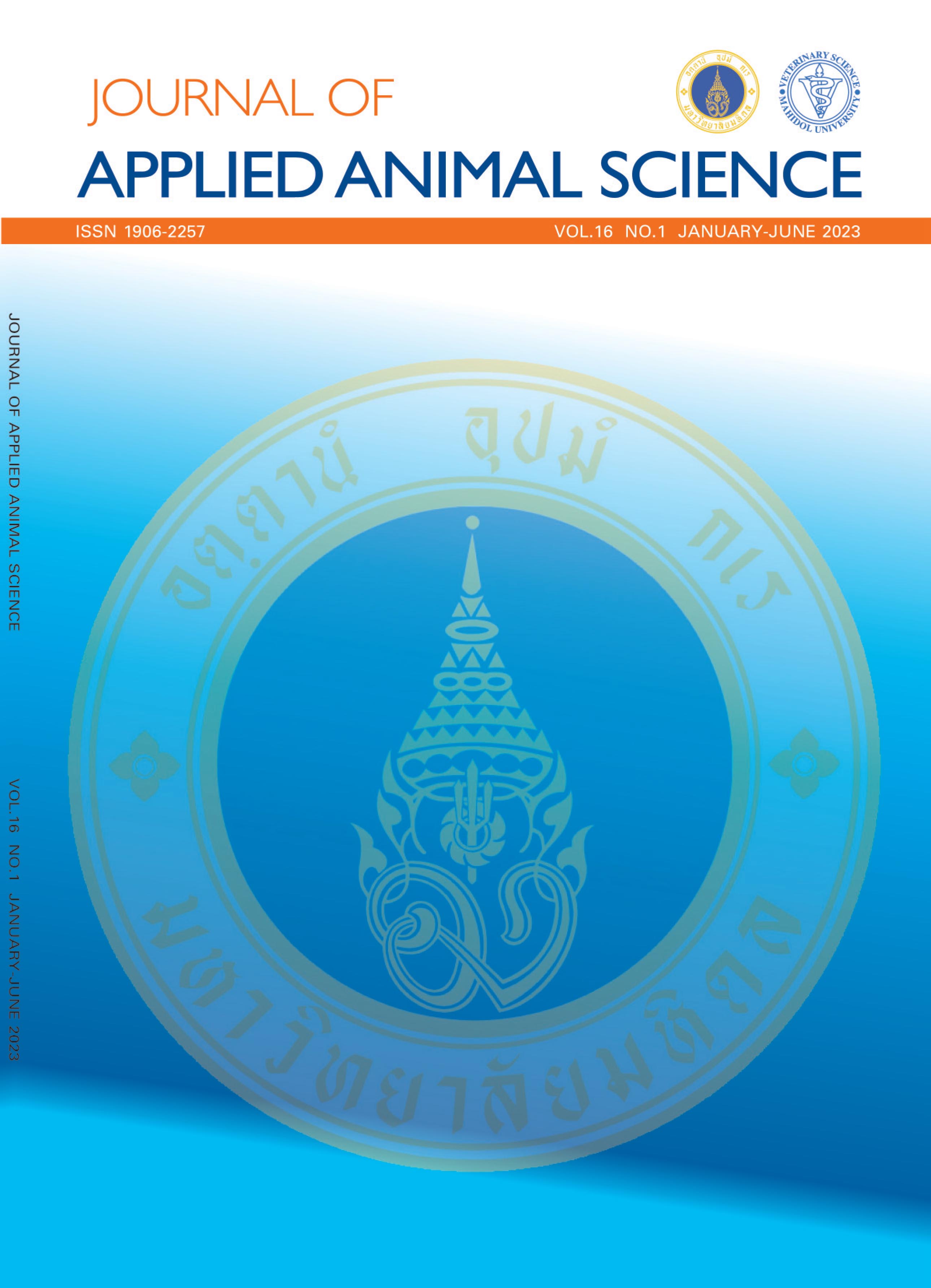A Case Report of Canine Pure Red Cell Aplasia in Middle-Aged Male Pomeranian
Keywords:
Pure red cell aplasia, non-regenerative anemia, syncopeAbstract
Canine pure red cell aplasia (PRCA) is a rare pathological condition in dogs related to a lack of erythroid precursor linages that cause a failure of red blood cell production, leading to severe anemia. Middle-aged dogs, especially females, have a great chance of developing acquired pure red cell aplasia. The clinical signs show pale mucous membrane, systolic murmur, tachypnea, tachycardia, weakness, syncope, and seizure. For diagnosis, the clinical pathological findings show the normocytic normochromic non-regenerative anemia, and the bone marrow pathological findings show a lack of erythroid precursor cells. According to the responsiveness of the immunosuppressive therapy, PRCA is proposed as one form of the immune-mediated anemia. Most PRCA are secondary diseases associated with recombinant human erythropoietin (rhEPO) treatment, infectious disease including parvoviral infection or modified-live parvovirus vaccination, or bone marrow cancer. In case of poor prognosis, the histopathology shows collagenous fibrosis in the bone marrow, and recurrent diseases after withdrawing the treatment commonly occur. In this case study, an 11-year-old non-castrated male Pomeranian dog was presented with a history of syncope. The non-regenerative anemia was found with a decrease of erythroid precursor in the bone marrow. The dog has been successfully treated with prednisolone 2 mg/kg once daily and tapered down every two weeks. The clinical signs of syncope and other blood parameters improved after 2 weeks of treatment.
References
Akiyoshi M. Precursor-targeted immune-mediated anemia in a dog with a stage IV mast cell tumor and bone marrow infiltration. Vet Clin Pathol. 2021;50:151-7.
Assenmacher TD, Jutkowitz LA, Koenigshof AM, Lucidi CdA, Scott MA. Clinical features of precursor-targeted immune-mediated anemia in dogs: 66 cases (2004-2013). J Am Vet Med Assoc. 2019;255(3):366-76.
Brooks MB, Harr KE, Seelig DM, Wardrop KJ, Weiss DJ. Schalm's Veterinary Hematology. 7th ed. Pondicherry: Wiley; 2022.
Casadevall N, Nataf J, Viron B, Kolta A, Kiladjian J-J, Martin-Dupont P, et al. Pure red cell aplasia and antierythropoeitin antibodies in patients treated with recombinant erythropoietin. N Engl J Med. 2002;346(7):469-75.
Choi JH, Oh YH, Park IK. A case of pure red cell aplasia associated with angioimmunoblasticT-cell lymphoma. Cancer Res Treat. 2010;42(2):115-7.
Eisa MS, Al-Tikrity MA, Babikikir MM, Yassin MA. Thrombocytopenia secondary to iron deficiency anemia responding to iron therapy. Clin Case Rep. 2021;9(7):1-4.
Ettinger SJ, Feldman EC. Textbook of veterinary internal medicine. 7th ed. St. Louis: Elsevier; 2000.
Ettinger SJ, Feldman EC, Cote E. Textbook of Veterinary Internal Medicine: Diseases of the dog and the cat. 8th ed. St. Louis: Elsevier; 2017.
Fiocchi EH, Cowgill LD, Brown DC, Markovich JE, Tucker S, Labato MA, et al. The Use of Darbepoetin to Stimulate Erythropoiesis in the Treatment of Anemia of Chronic Kidney Disease in Dogs. J Vet Intern Med. 2017;31(2):476-85.
Javinsky E. Hematology and Immune-Related Disorders. In: Little SE, editor. The Cat: Clinical medicine and management. St. Louis: Elsevier; 2012. p. 643-703.
Lippi I, Perondi F, Lubas G, Gori E, Pierini A, D'Addetta A, et al. Erythrogram Patterns in Dogs with Chronic Kidney Disease. Vet Sci. 2021;8(7):123.
Lobbes H. Pure red cell aplasia: Diagnosis, classification and treatment. Rev Med Interne. 2023;44(1):19-26.
Lucidi CA, de Rezende CLE, Jutkowitz LA, Scott MA. Histologic and cytologic bone marrow findings in dogs with suspected precursor-targeted immune-mediated anemia and associated phagocytosis of erythroid precursors. Vet Clin Pathol. 2017;46(3):401-15.
Lucidi CA. Precursor-Targeted Immune-Mediated Anemia and Pure Red Cell Aplasia in Dogs and Cats. In: Brooks MB, Harr KE, Seelig DM, Wardrop KJ, Weiss DJ, editors. Schalm's Veterinary Hematology. 7th ed. Pondicherry: Wiley; 2022. p. 307-12.
Means J, Robert T. Pure red cell aplasia. Blood. 2016; 128(21):2504-9.
Parrish CR. Pathogenesis of feline panleukopenia virus and canine parvovirus. Baillidres Clin Haematol. 995;8(1):57-71.
Plumb DC. Plum's Veterinary Drug Handbook. 7th ed. Wis-consin: Wiley; 2011. p. 2973-86.
Reinero C, Visser LC, Kellihan HB, Masseau I, Rozanski E, Clercx C, et al. ACVIM consensus statement guidelines for the diagnosis, classification, treatment, and monitoring of pulmonary hypertension in dogs. J Vet Intern Med. 2020;34(2):549-73.
Sawada K, Fujishima N, Hirokawa M. Acquired pure red cell aplasia: updated review of treatment. Br J Haematol. 2008;142(4):505-14.
Schijvens AM, Ter Heine R, de Wildt SN, Schreuder MF. Pharmacology and pharmacogenetics of prednisone and prednisolone in patients with nephrotic syndrome. Pediatr Nephrol. 2019;34(3):389-403.
Stokol T. Idiopathic pure red cell aplasia and nonregenerative immune-mediated anemia in dogs: 43 cases (1998-1999). J Am Vet Med Assoc. 2000; 216(9):1429-36.
To I, Boelsterli PR, Walter JJ, Rutland BE. Suspected primary pure red cell aplasia in a 4-month-old intact male mixed Bernese moutain dog. Can Vet J. 2021;62:408-12.
Weiss DJ. Bone marrow pathology in dogs and cats with non-regenerative immune-mediated haemolytic anaemia and pure red cell aplasia. J Comp Pathol. 2008;138(1):46-53.
Weiss DJ, Wardrop KJ. Schalm's Veterinary Hematology. 6th ed. Iowa: Wiley; 2011.
Downloads
Published
How to Cite
Issue
Section
License
Copyright (c) 2023 Mahidol University Faculty of Veterinary Science

This work is licensed under a Creative Commons Attribution-NonCommercial-NoDerivatives 4.0 International License.
Published articles are under the copyright of the Journal of Applied Animal Science (JAAS) effective when the article is accepted for publication. The editorial boards claim no responsibility for the content or opinions expressed by the authors of individual articles in this journal. Partially or totally publication of an article elsewhere is possible only after the consent from the editors.



